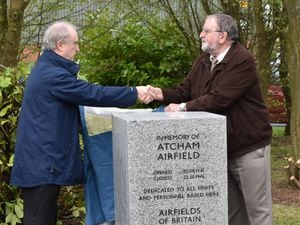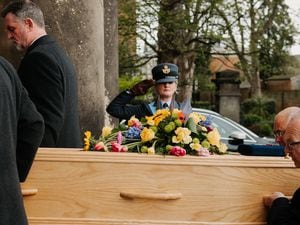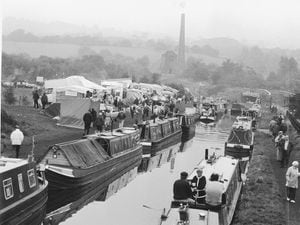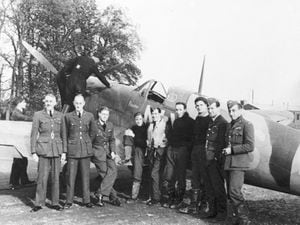Unlocking magical memories of canalside holidays
For a four-year-old child, the holiday with a Shropshire lock keeper was a magical, never-to-be forgotten adventure.
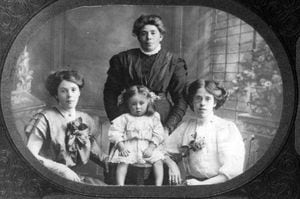
And Connie's story, which has been recorded for posterity by her son Peter Morrey, is an insight into the days when the canal system was still a working transport artery, before its decline and eventual rebirth as a leisure and tourist attraction enjoyed today by boating enthusiasts and visitors.
Peter – originally from Penn Common, Wolverhampton, but who has lived in Aberdeenshire for the past 30 years – said: "Connie said to me many times that she could remember in detail about the times during the summer holidays in about 1913 to 1916, when she would visit her maternal grandparents."
Those grandparents were Thomas Price, the manager at Frankton Locks, near Ellesmere, and wife Sarah.
Connie's mum and dad, Agnes and Percy Jones, would put her and her older brothers, Laddie, Ewart and Bobby, on the train in Wolverhampton in the care of the train's guard, bound for the Shropshire countryside.
"Sarah would meet them some hours later, in her pony and trap, outside Whittington Station. Can you imagine that, Connie aged four years old, and her three brothers, aged up to eight, travelling on the train without an adult?
"Well, as mum said, you can imagine the excitement, greeting her grandmother Sarah, piling out of the railway station, into the horse and trap, one at a time."
As they started to climb the hill towards the village of Welsh Frankton, the pony would be down to a walk, and the children had to walk besides the trap to lighten the load on the pony.
"St Andrew's Church is on the left, which is where Thomas and Sarah Price were buried in June 1920 and March 1936 respectively in a grave marked 'The Manager Frankton Lock'."
The couple lived at Frankton Locks Cottage, with the ground floor starting about 10ft below the water level of the canal, and the first floor windows about level with the ground on either side of the canal.
"If one goes beyond the Locks Cottage, the next house you come to, according to my mother, is uncle Harry and aunt Polly Edgerton's black and white canalside house and nearby boat building and repair sheds."
Peter says: "My mother told me there was a wooden bridge built, about 12 inches wide, between the canal bank and the upstairs window of the cottage, and a wickerwork basket was mounted on a wire and pulley system to take the letters and other post across the bridge.
"A bell was mounted on the canal bank end. You can just imagine the complete thrill that this would cause.
"A very excited Connie would sit in the upstairs window for half an hour before 8.30 when the postman would come on his bike. When she saw him coming she would shout 'The postman’s coming nanny', and the ‘postie’ would ring the bell, put about a dozen letters in the basket, pull the string, and the basket would go across the bridge to the window.
"Connie would take the letters out of the basket, wind the basket back, and say 'Thank You Mr. Postman'.
"They used to have six weeks holiday there, you can imagine how much they used to enjoy it.
"Her big brother Laddie would take a flying leap, up and over the lock just before the lock gates, six feet wide, and 12ft deep, when grandpa was not about. Very frightening!
"Harry Edgerton was rather an expert in carving wooden structures and manufacturing copper kettles and other chandlery. He made a hardwood high chair for Connie when she was a baby, and also made a copper kettle for her mother Agnes, both of which we have at home."
Peter says that in the 19th century the canal provided transportation for burnt limestone to the canalside limekilns, to become agricultural fertiliser for farms far and wide.
"Thomas Price, my great-grandfather and the lock manager, said that the fertiliser went by horse-drawn barge, mainly to local distribution points.
"It was occasionally taken up the Llangollen Canal to Whitchurch, then Nantwich, and, via the junction with the Shropshire Union Canal, up by Wardle in Cheshire, at which point the barge could either turn right for Market Drayton and points south for the Midlands, or north either to Wales or to Ellesmere Port, and then by coastal cutters to northern England.
"Payloads for the return journey would either be made up of timber, from seagoing ships, or, from Staffordshire, there might be leather goods from Walsall, locks from Willenhall, or nails from Wombourne."
Thomas died on June 27, 1920, and Peter says he was probably not replaced, as the profitability of the canal was in decline. Sarah lived at the canalside cottage nearly until her death at the age of 76.
"By the early 1920s the struggling Montgomery Canal, which by 1923 was owned by the London, Midland and Scottish Railway Company, was no longer viable. The canal was finally abandoned in 1944, following a breach of the waterway at Perry Aqueduct just below Frankton Locks," says Peter.
In more modern times, he says, interest in the Montgomery Canal was raised as the result of proposals being made to build a bypass at Welshpool, around the line of the canal.
"A group of enthusiasts from the Inland Waterways Association, the Shropshire Union Canal Society, and the local community, set to and cleaned out the canal, and reopened the section to boats."
So far as Peter is aware his mother never went back to Frankton Locks in later life, but she remembered it in detail and he wrote it all down for his children.
She lived for most of her life in the Penn area of Wolverhampton, and died in a care home at Trysull in 1992.
Peter was to make a visit to the Frankton Locks in 1986.
"The canal was empty, and we saw all the buildings mentioned in the story. In 2002 my late nephew Paul Morrey took the photos when the canal had been refurbished and refilled."


